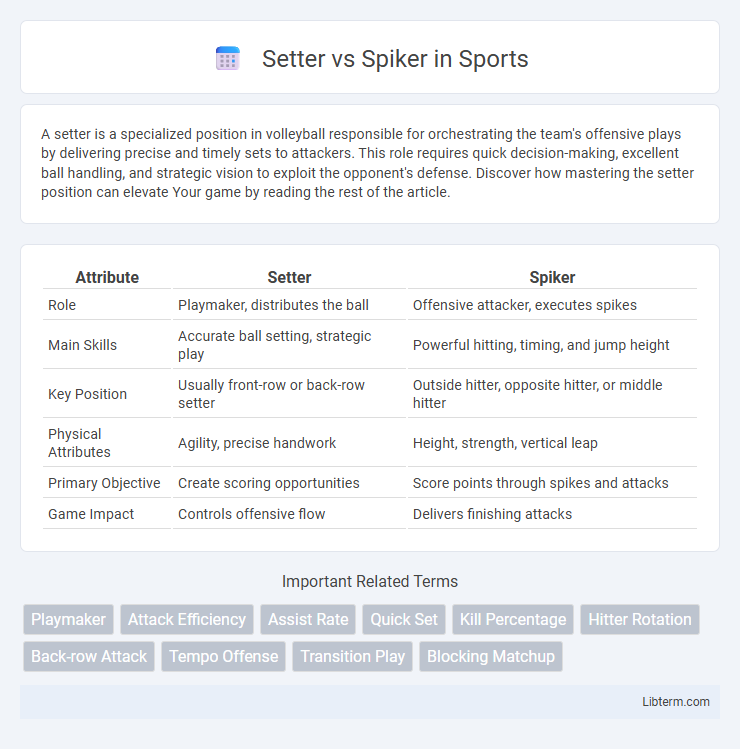A setter is a specialized position in volleyball responsible for orchestrating the team's offensive plays by delivering precise and timely sets to attackers. This role requires quick decision-making, excellent ball handling, and strategic vision to exploit the opponent's defense. Discover how mastering the setter position can elevate Your game by reading the rest of the article.
Table of Comparison
| Attribute | Setter | Spiker |
|---|---|---|
| Role | Playmaker, distributes the ball | Offensive attacker, executes spikes |
| Main Skills | Accurate ball setting, strategic play | Powerful hitting, timing, and jump height |
| Key Position | Usually front-row or back-row setter | Outside hitter, opposite hitter, or middle hitter |
| Physical Attributes | Agility, precise handwork | Height, strength, vertical leap |
| Primary Objective | Create scoring opportunities | Score points through spikes and attacks |
| Game Impact | Controls offensive flow | Delivers finishing attacks |
Introduction to Setter and Spiker Roles
Setters orchestrate offensive plays by delivering precise sets that enable hitters to attack effectively, acting as the team's tactical brain on the court. Spikers, also known as hitters, focus on executing powerful attacks aimed at scoring points by driving the ball into the opponent's court. These distinct roles require setters to possess exceptional hand-eye coordination and strategic vision, while spikers rely on timing, vertical leap, and hitting accuracy.
Key Responsibilities of a Setter
Setters are primarily responsible for orchestrating the offensive play by accurately delivering the ball to spikers in optimal positions. They must possess sharp decision-making skills and quick reflexes to adjust sets based on the dynamic positioning of blockers and defenders. Mastery in precise ball control and strategic vision distinguishes setters, enabling them to control the pace and flow of the game effectively.
Key Responsibilities of a Spiker
The spiker's key responsibilities include executing powerful and precise attacks to score points by hitting the ball over the net into the opponent's court, often after the setter delivers an optimal set. They must exhibit excellent timing, strong jumping ability, and spatial awareness to avoid blockers and target weak spots in the defense. Defensive duties such as blocking opponent spikes and transitioning quickly into defense after an attack are also critical components of a spiker's role.
Essential Skills for Setters
Setters require precise ball-handling skills, exceptional court vision, and quick decision-making to deliver accurate and timely sets that enable spikers to execute powerful attacks. Mastery of hand positioning, finger strength, and footwork are critical for setters to maintain control and adaptability under pressure. Developing strong communication and anticipation skills ensures effective coordination with hitters, maximizing offensive strategies in volleyball.
Essential Skills for Spikers
Spikers must master explosive power and precise timing to execute powerful and accurate attacks that break through opposing blocks. Exceptional hand-eye coordination and strong jumping ability enhance their effectiveness in scoring points from various angles. Developing quick decision-making skills enables spikers to adapt rapidly to setters' ball placements and defenders' positioning.
Setter vs Spiker: Differences in Training
Setters focus their training on precision, strategic decision-making, and quick reflexes to orchestrate offensive plays, emphasizing ball control and accurate finger placement. Spikers prioritize explosive power, vertical jump height, and arm swing mechanics to maximize attack efficiency and scoring potential. While setters develop agility and tactical awareness for setting up attacks, spikers train for strength, timing, and hitting techniques to break through blocks.
Impact on Team Strategy
The setter serves as the team's primary playmaker, orchestrating offensive attacks by delivering precise sets tailored to the spiker's strengths, thereby influencing the pace and variability of gameplay. The spiker executes powerful attacks, converting sets into points and applying pressure on the opponent's defense, which forces defensive adjustments and creates scoring opportunities. Together, their synergy shapes the team's offensive rhythm and strategic adaptability, critical for maintaining competitive advantage during matches.
Physical and Mental Demands
Setters require exceptional agility, quick reflexes, and sharp decision-making skills to coordinate offensive plays under pressure. Spikers demand explosive strength, vertical leap, and timing precision to execute powerful attacks against blockers. Both roles involve intense mental focus and resilience, but setters must maintain strategic awareness while spikers rely heavily on physical power and coordination.
Famous Setters and Spikers in Volleyball History
Famous setters like Giovanni Guidetti and Karch Kiraly revolutionized volleyball with their precise ball distribution and strategic playmaking, setting up countless successful attacks. Legendary spikers such as Giba and Ivan Zaytsev are celebrated for their powerful hits and scoring ability, dominating the net with speed and accuracy. These iconic players have shaped the roles of setters and spikers by showcasing elite skills that define volleyball's dynamic offense.
Choosing Between Setter and Spiker: Which Role Suits You?
Choosing between setter and spiker depends on your skill set and playing style; setters excel in precise ball handling and strategic playmaking, controlling the game's tempo. Spikers prioritize power, timing, and aggressive attacking skills to score points through spikes and tips. Assess your strengths in coordination, agility, and decision-making to determine which role aligns better with your abilities and team dynamics.
Setter Infographic

 libterm.com
libterm.com